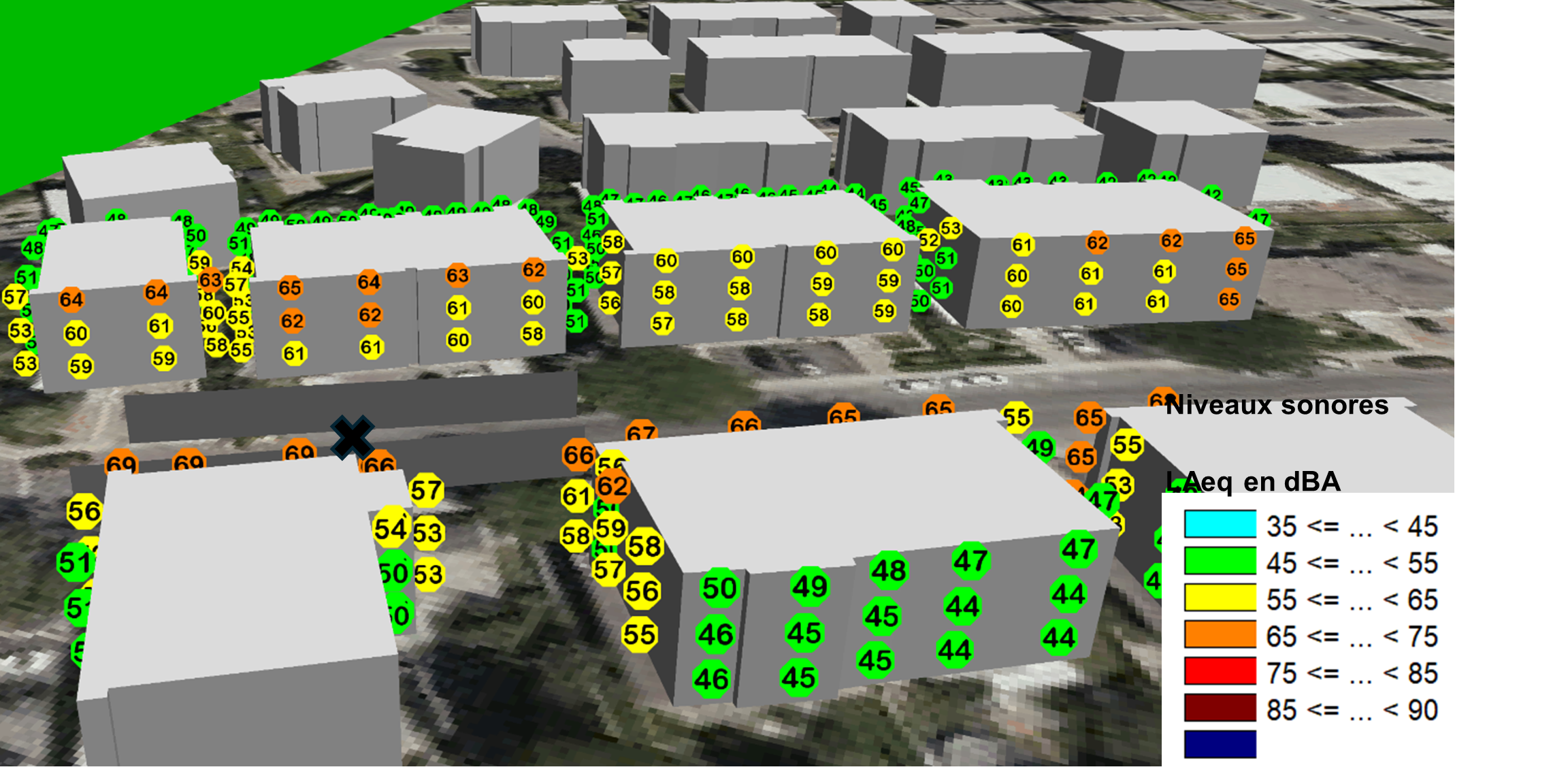Noise Modelling
Noise modelling is crucial for construction work, especially when projects are carried out in sensitive areas. In addition to ensuring compliance with standards, it optimizes performance by anticipating and minimizing negative noise impacts.
ASSESSING NOISE POLLUTION
Construction work can generate high levels of noise associated with machinery, heavy equipment, and even the delivery of materials. Acoustic modelling makes it possible to accurately assess how noise travels through the surrounding environment, to determine sound levels in different areas, and to identify potential nuisance factors for residents or users of nearby buildings. This allows preventive measures to be implemented before work even begins.
Figure 1 shows an example of acoustic simulations for construction work in a residential area.

STANDARDS AND REGULATORY COMPLIANCE
Strict noise standards and regulations apply to construction sites and related work. For example, different noise limits apply to specific times of day and at night. Acoustic modelling makes it possible to confirm that a project will meet these requirements and to obtain the authorizations needed to start work. If noise levels exceed applicable limits, corrective measures can be taken. For example, noise barriers can be installed or the use of specific equipment can be restricted to certain hours.
ANTICIPATING IMPACTS ON THE SOUND ENVIRONMENT
Acoustic modelling is used to simulate a construction project’s impact on the surrounding sound environment (including noise affecting sensitive areas like schools, hospitals, and residential neighbourhoods). Such a simulation can account for various parameters, including the following:
- Sources of noise: Identification of equipment generating noise
- Weather conditions: The effect of temperature, humidity, and wind on how sound travels
- Natural attenuation: How topography and snow can help reduce noise
This information makes it possible to reduce negative noise impacts by making adjustments based on how and where work is being carried out.
MANAGIND DISPUTES AND COMPLAINTS
Noise pollution is a common source of complaints from residents when construction is underway. Properly executed acoustic modelling provides an objective, scientific way of quantifying and predicting noise levels. It also promotes constructive dialogue with local residents by providing them with tangible data and by justifying any changes to on-site practices.
OPTIMIZING NOISE REDUCTION SOLUTIONS
After identifying sensitive areas and assessing noise levels, acoustic modelling can be used to design targeted, effective noise reduction solutions. This can include:
- installing noise barriers around the site,
- rescheduling certain project phases to limit noisy work during sensitive periods (early morning or night),
- optimizing logistics and transportation by avoiding travel through residential areas during busy periods.
Figure 2 shows an example of a mitigation measure that may be implemented based on acoustic modelling (this is just one example that may not necessarily comply with municipal regulations or be feasible in all circumstances).

IMPROVING SUSTAINABILITY AND INCREASING PUBLIC ACCEPTANCE
By addressing noise issues from the very start of the design process, acoustic modelling facilitates planning and helps avoid unforeseen costs associated with changing course after work is underway. It helps make the project more sustainable and acceptable to the local community. More than ever, public acceptance is a key factor for the success of construction projects. A proactive approach to dealing with noise issues is one way of ensuring acceptance.
REDUCING THE LONG-TERM NOISE FOOTPRINT
Finally, the benefits of acoustic modelling are not limited to the construction period. It also helps predict a project’s post-completion noise impact. For instance, if the project involves the installation loud equipment (ventilation systems, industrial machinery, commercial infrastructure, etc.), acoustic modelling can help determine whether these features will introduce additional nuisance factors for occupants or neighbours.
Figure 3 shows a 3D view of the model and the calculated noise levels at building facades.

ACOUSTIC MODELLING FOR CONSTRUCTION WORK IS CRITICAL FOR:
- Preventing and reducing noise pollution,
- Ensuring regulatory compliance,
- Increasing public acceptance of the project,
- Optimizing the use of noise reduction technology.
It provides a solid basis for proactive noise and nuisance management, ensuring the project blends in with its surroundings.








